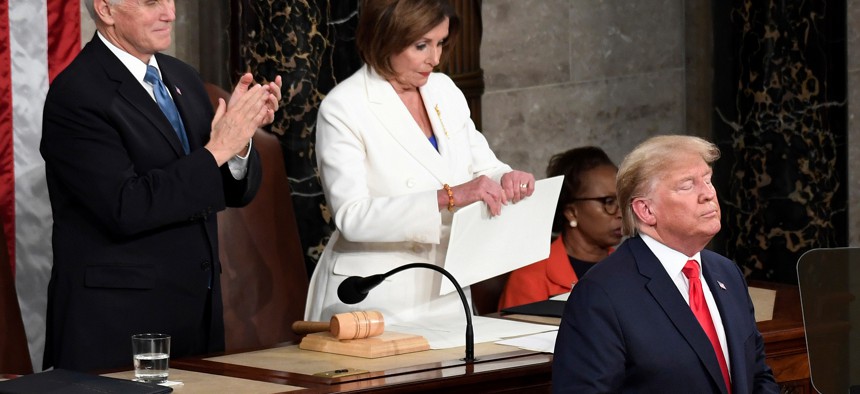
House Speaker Nancy Pelosi, D-Calif., tears her copy of President Donald Trump's s State of the Union address after he delivered it to a joint session of Congress on Capitol Hill in Washington, on Tuesday, Feb. 4, 2020. Vice President Mike Pence applauds AP Images
To Block Trump’s Troop Withdrawals, Congress Turns An Old Tactic Upside Down
Congress historically has tried to force presidents to bring troops home. But in the last three years, lawmakers have repeatedly tried to make laws to do the opposite.
A bipartisan group of House lawmakers who want to stop President Donald Trump from pulling U.S. troops from military conflicts and overseas bases are using a once-unusual tactic that has in the last three years become Congress’ go-to tool.
Lawmakers from the Senate and the House have in the last three years sought to use legislation to prevent the president from pulling troops from Afghanistan, Syria, South Korea, and now Germany — unless the administration certifies that a withdrawal will not harm U.S. or allied interests.
It’s an unusual reversal for Congress, which historically is far more likely to seek to force a return of American troops, not demand that they remain deployed. According to Danielle Lupton, a Colgate University professor who has tracked foreign policy and defense votes since the late 1970s, “the overwhelming majority of votes related to use of force or troop deployments” have sought to bring troops home or constrain the president from using force. Although there are a few cases where Congress voted to support a deployment, Lupton said, it was typically a friendly legislature acting symbolically to reaffirm the president’s foreign policy.
But as lawmakers on both sides of the aisle have grown increasingly concerned about the decision-making behind Trump’s withdrawal efforts — described by former administration officials as erratic, impulsive outbursts driven by domestic politics — this unconventional tactic has gained popularity.
“He’s not a strategic thinker, but he has some instincts that have been consistent,” said John Owen, head of the University of Virginia’s Department of Politics. “One of those is that the U.S. has fought a lot of worthless wars, in particular Iraq and Afghanistan, and the second is that the U.S. is being exploited by freeriding allies. The problem he has is that very few in Congress agree with him.”
There is precedent for the political tactic underlying the demand for certification, said Peter Feaver, a civil-military relations scholar at Duke University — but in that instance, Congress was seeking to block further use of force, not prolong it. In 2007, Congress did not explicitly prevent funding for then-President George W. Bush’s Iraq surge, but it did require the president certify certain benchmarks had been met before any of the funds made available for Iraq could be spent.
Congressional Democrats opposed to the war were “trying to block the surge — kill it with a thousand cuts — but in a way that will not saddle the Democrats for the blame and will not make it look like Democrats are voting against funding our troops while they're in combat,” Feaver said, an allegation Republicans made at the time. “The technique they hit upon was to tie the funding to the Department of Defense certifying the DOD's own standards were being met.
“That's essentially what Congress is doing to Trump, but it's in reverse,” Feaver said. “In either case, the Congress is saying, ‘we can't stop you from doing this, we're just going to insist you meet these standards, which are your own standards, which are objectively reasonable.”
It was a political tactic that failed for political reasons, Feaver said: In 2007, it was easy for Republicans to paint the Democratic opposition as hamstringing U.S. troops while they were in battle.
But the Congress has several advantages in 2020 that make the 2007 Iraq surge an inexact precedent. For one thing, the interest in maintaining troops overseas in defiance of Trump’s prerogatives is bipartisan. A broad swath of Republicans — including Senate Majority Leader Mitch McConnell — have opposed Trump’s wild swings for the exits, and have backed this kind of legislation. And for another thing, Feaver said, “I think it's a game-changing advantage [that] Trump doesn't have a coherent interagency process underlying these moves.”
Beginning on the campaign trail in 2016, Trump has made no secret of his desire to remove U.S. troops from American bases around the world, both in active conflict zones and permanent stations designed to project U.S. force into Asia and Europe. In December 2018, he shocked Congress with an abrupt announcement that he would withdraw the 2,000 U.S. troops fighting ISIS in Syria. Even at the time, key GOP leaders expressed concerns that there had been no interagency deliberation behind the decision.
In a recent memoir recounting his time in the White House, former National Security Advisor John Bolton also described the president as demanding complete withdrawals from nations around the globe, over the apparently unanimous counsel of his advisors and often without warning. Failing to present policy prescriptions in the right way at the right time “risked another outburst in which Trump would demand we withdraw everyone immediately,” Bolton wrote. “Not presenting them meant withdrawal by default.” Trump also explicitly linked withdrawal efforts to his reelection prospects, rather than national security prerogatives, Bolton alleged, quoting Trump as saying of a then-pending peace deal with the Taliban in 2019: “Don’t mention ‘withdrawal’ in the statement, but say we will go to zero in October [2020] right before the election. We could push it past the election. How does it look politically?”
Among many mainstream Republicans in Congress, Trump’s myriad withdrawal efforts are deeply unpopular. The House version of the annual defense policy bill, scheduled for a vote next week, would ban the administration from lowering troop levels in Germany below their current benchmark of 24,500 until the Pentagon presents a plan to Congress and certifies that the cuts won’t harm U.S. interests. (Trump has long been frustrated with Germany’s failure to meet a 2 percent defense spending benchmark set out by NATO.) The same bill places similar restrictions on cutting troops in Afghanistan below 8,000 without certifying that a withdrawal “will not increase the risk for the expansion of existing or formation of new terrorist safe havens inside Afghanistan” and “will not compromise or otherwise negatively affect the ongoing United States counter terrorism mission against the Islamic State, al Qaeda, and associated forces.” In the Senate, Sens. Mitt Romney, R-Utah, Lindsey Graham, R-S.C., and Marco Rubio, R-Fla., joined with prominent Democrats to offer a similar amendment to the Senate version of the bill limiting troop cuts in Germany.
Lawmakers in the Senate also passed nonbinding legislation in 2019 calling on the Trump administration to certify the “enduring” defeat of ISIS and other Islamist terror groups before any embarking on any significant withdrawal from Syria or Afghanistan.
In the 2018 military spending bill, known as the National Defense Authorization Act, or NDAA, the Congress put a restriction on reducing the number of active-duty troops stationed in South Korea below 22,000 without a certification from then-Secretary of Defense Jim Mattis that the move would be in U.S. interests and would not undermine the security of American allies in the region.
Lupton, Owen and others question the enforceability of these measures. But even if the efforts are primarily symbolic, Owen said, “they can have practical consequences.” For Lupton, the primary benefit is that the legislation puts more information into Congress’s hands, allowing lawmakers to beef up their oversight of the Pentagon’s activities. Owen noted that it might also give the administration — separate from Trump — the opportunity to stall any withdrawal efforts they consider precipitous or ill-considered.
“Amendments in an NDAA can raise more obstacles within the executive branch if the White House wants to do something,” Owen said. “Let’s say you’re a high Pentagon official and you’re not really for this, but you have this amendment in the NDAA saying the administration has to give us reasons for this drawdown — I think it can have consequences. It’s not just some words on a page.”
There are some constitutional concerns with the tactic. In a signing statement on the 2018 defense bill, Trump said that he could ignore the restrictions against cutting troops in South Korea, citing “the longstanding understanding of the executive branch that these types of provisions encompass only actions for which such advance certification or notification is feasible and consistent with the President’s exclusive constitutional authorities as Commander in Chief and as the sole representative of the Nation in foreign affairs.”
But even in the signing statement, Trump did not suggest that attempting to regulate withdrawal by statute was on its face unconstitutional, objecting instead to the imposition of the certification requirements.
And for Owen and others, the question may be an academic one confined to White House-Hill relations during the Trump administration. In a more conventional presidency, Owen said, it’s likely the use of the tactic would fade.
“Supposing Trump loses and [presumptive Democratic nominee Joe] Biden is in office, Biden is part of this mainstream and I think the problem would go away — if you see it as a problem,” Owen said.




